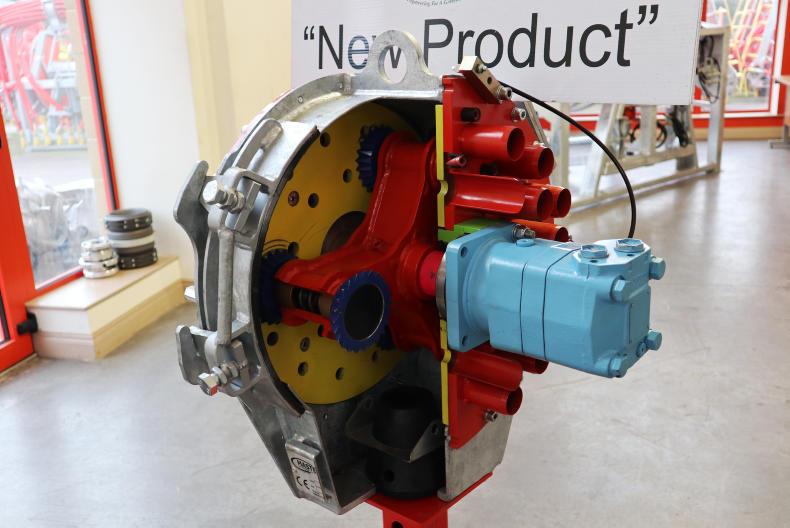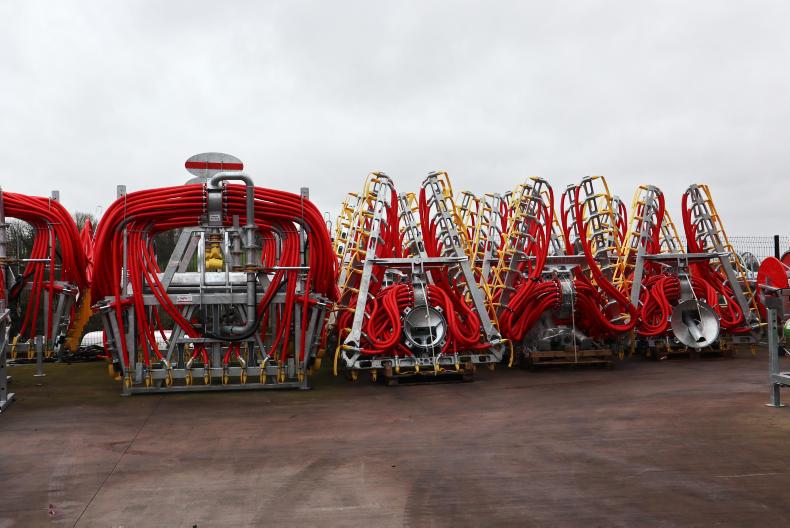Mastek, based in Cootehill, Co Cavan, which manufactures slurry handling equipment, forklift masts, subsoilers and other grassland equipment, has spent years developing a macerator suitable for Irish conditions.
The company was founded in 2000 after landing a deal producing forklift masts for local company, Combilift in Co Monaghan. Mast production still plays a major part of the business today, accounting for 20% of the overall business.
Due to the economic downturn in 2008 and the hugely reduced number of masts leaving the yard in Cootehill, this meant the business had to quickly diversify. This was in the area of slurry handling equipment, which now accounts for the other 80% of the business.
Mastek took home the Global Ambition Award at this year’s National Ploughing Championships, as a result of sales across the globe, with markets in Scandinavia, Australia and New Zealand, as well as the UK and Ireland.
TAMS grants have left Paul and his team exceptionally busy as many people are making the switch to low-emission spreading methods.
According to Paul, farmers are grant-eligible for these low-emission dribble bar systems, without the need for replacing their existing tankers.

A cutaway of the macerator shows its simplistic but effective design.
SuperCut macerator
The Mastek SuperCut macerator has been on the market for five years. Following customer issues and feedback with the earlier model to the market, Paul and his team have constantly been overcoming issues and redesigning aspects of their macerator. Today, Paul is extremely confident in his product. “A lot of time and effort went into developing the SuperCut, years of trial and error, eliminating issues as they arose, often as a result of solving others,” he said.
Numerous units of the latest patented design are now in their second season trouble-free, having sold no replacement parts, Paul said. The sectioned view SuperCut was on show at this year’s Ploughing, showing its simplicity and working principle.
Air is key: each outlet has its own non-return air breather, as opposed to one large air breather. This is key for optimum slurry flow and helps to eliminate blockages, according to Paul. Knife cutters: each unit consist of six rotating, brass bushed, conical-like cutters. All have V-shaped channels, increasing surface cutting area, and as a result each unit has 2.5m of cutting edge. These V-shaped channels also create a serrated cutting effect, making cutting of highly fibrous slurry and even plastic easier, similar to serrated-edged knives. Nylon inserts are placed into each sprung knife cutter, to reduce contact friction with the Hardox wear plates. Paul reckons the efficiency of his concept should remove the need for an inlet macerator when sucking slurry.
Stock awaiting delivery to customers
Hydraulic oil isolation block: this was developed by Mastek in response to customers having issues where motor seals failed, emptying the tractor of hydraulic oil straight into the macerator as result, usually without the operator noticing. The block sees double-wiper seals, along with a grease filled chamber. The chamber is filled with grease until it becomes visible, so in the unlikely event of seal failure, the oil will push out the grease through the overflow pipe. The oil will follow but this should be enough to alert the operator and cease pumping, saving both on oil and potential mechanical damage.
Rubber flow control cones can be integrated into the inlet side of the macerator, doing essentially what it says on the tin, controlling the flow of slurry. Issues arose where slurry was entering and exiting the SuperCut too fast. This rubber cone reduces flow upon entry, meaning operators can travel slower to achieve desired application.PTO driven compressor
Mastek has recently launched its PTO compressor. This is a compact, front-linkage, mounted compressor to complete the range of slurry equipment without the need for pulling round a trailed compressor. With an output capacity of 250CFM, it is more than capable of any application. Savings in fuel can be made from a compressor like this as it is driven by the tractor engine and not an independent engine.
Mastek, based in Cootehill, Co Cavan, which manufactures slurry handling equipment, forklift masts, subsoilers and other grassland equipment, has spent years developing a macerator suitable for Irish conditions.
The company was founded in 2000 after landing a deal producing forklift masts for local company, Combilift in Co Monaghan. Mast production still plays a major part of the business today, accounting for 20% of the overall business.
Due to the economic downturn in 2008 and the hugely reduced number of masts leaving the yard in Cootehill, this meant the business had to quickly diversify. This was in the area of slurry handling equipment, which now accounts for the other 80% of the business.
Mastek took home the Global Ambition Award at this year’s National Ploughing Championships, as a result of sales across the globe, with markets in Scandinavia, Australia and New Zealand, as well as the UK and Ireland.
TAMS grants have left Paul and his team exceptionally busy as many people are making the switch to low-emission spreading methods.
According to Paul, farmers are grant-eligible for these low-emission dribble bar systems, without the need for replacing their existing tankers.

A cutaway of the macerator shows its simplistic but effective design.
SuperCut macerator
The Mastek SuperCut macerator has been on the market for five years. Following customer issues and feedback with the earlier model to the market, Paul and his team have constantly been overcoming issues and redesigning aspects of their macerator. Today, Paul is extremely confident in his product. “A lot of time and effort went into developing the SuperCut, years of trial and error, eliminating issues as they arose, often as a result of solving others,” he said.
Numerous units of the latest patented design are now in their second season trouble-free, having sold no replacement parts, Paul said. The sectioned view SuperCut was on show at this year’s Ploughing, showing its simplicity and working principle.
Air is key: each outlet has its own non-return air breather, as opposed to one large air breather. This is key for optimum slurry flow and helps to eliminate blockages, according to Paul. Knife cutters: each unit consist of six rotating, brass bushed, conical-like cutters. All have V-shaped channels, increasing surface cutting area, and as a result each unit has 2.5m of cutting edge. These V-shaped channels also create a serrated cutting effect, making cutting of highly fibrous slurry and even plastic easier, similar to serrated-edged knives. Nylon inserts are placed into each sprung knife cutter, to reduce contact friction with the Hardox wear plates. Paul reckons the efficiency of his concept should remove the need for an inlet macerator when sucking slurry.
Stock awaiting delivery to customers
Hydraulic oil isolation block: this was developed by Mastek in response to customers having issues where motor seals failed, emptying the tractor of hydraulic oil straight into the macerator as result, usually without the operator noticing. The block sees double-wiper seals, along with a grease filled chamber. The chamber is filled with grease until it becomes visible, so in the unlikely event of seal failure, the oil will push out the grease through the overflow pipe. The oil will follow but this should be enough to alert the operator and cease pumping, saving both on oil and potential mechanical damage.
Rubber flow control cones can be integrated into the inlet side of the macerator, doing essentially what it says on the tin, controlling the flow of slurry. Issues arose where slurry was entering and exiting the SuperCut too fast. This rubber cone reduces flow upon entry, meaning operators can travel slower to achieve desired application.PTO driven compressor
Mastek has recently launched its PTO compressor. This is a compact, front-linkage, mounted compressor to complete the range of slurry equipment without the need for pulling round a trailed compressor. With an output capacity of 250CFM, it is more than capable of any application. Savings in fuel can be made from a compressor like this as it is driven by the tractor engine and not an independent engine.








 This is a subscriber-only article
This is a subscriber-only article









SHARING OPTIONS: